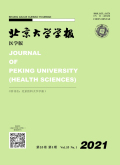北京大学学报(医学版)2024,Vol.56Issue(5):815-819,5.DOI:10.19723/j.issn.1671-167X.2024.05.010
中国某健康体检人群痔的流行病学特征
Epidemiological characteristics of hemorrhoids in a healthy physical examination population in China
摘要
Abstract
Objective:To describe the epidemiological distribution of hemorrhoids in a physical exami-nation population in China,which could provide evidence for precision prevention and early intervention of hemorrhoids.Methods:Chinese subjects over 18 years of age who underwent a physical examination in a nationwide chain of physical examination centers in 2018 were studied in a cross-sectional design,which collected information by a questionnaire and physical examination results from each subject.The epidemiological distribution of hemorrhoids was described using Logistic models.The gender-,age-,and region-detection rates of hemorrhoids were standardized to the Sixth National Population Census of the People's Republic of China(2010).Results:A total of 2 940 295 adult subjects were included in the study,of whom the average age was(41.7±14.0)years,and 52.6%were females.The standardized detection rate of hemorrhoids was higher for females(43.7%)than that for males(17.7%;P<0.001)in this study.In the females,the age distribution of hemorrhoids was inverted U-shaped,with the highest standardized detection rate of hemorrhoids in the age group of 30-39 years(63.5%).In the males,the standardized detection rate of hemorrhoids increased along with age,with the highest percentage of 17.2%in the age group of 50-59 years,and the standardized detection rate of hemorrhoids in the age group of 60 and above decreased slightly(P<0.001 for trend test).The participants with hypertension had a higher standardized detection rate of hemorrhoids than those with normal blood pressure in both males and females(P<0.001).The standardized detection rate of hemorrhoids showed a positive corre-lation with body mass index(P<0.001 for trend test in males).Conclusion:The detection rate of hemorrhoids varied to gender,age,obesity,and hypertension status,which could help to identify the risk factors and the high-risk sub-groups,and hence to strengthen health education and early detection accordingly,which could eventually reduce the incidence of hemorrhoids and improve the quality of life and health in the Chinese population.This study was conducted in a physical examination population,and the conclusions of this study should be extrapolated with caution.关键词
痔/健康检查/检出率Key words
Hemorrhoid/Physical examination/Detection rate分类
预防医学引用本文复制引用
郭呈华,王波,余灿清,车晓玉,林芝,蔡珊,刘国臻,潘烺,吕筠,李立明,满塞丽麦..中国某健康体检人群痔的流行病学特征[J].北京大学学报(医学版),2024,56(5):815-819,5.基金项目
2020年北京大学公共卫生学院医学部大学生创新实验项目Supported by 2020 Peking University School of Public Health Health Science Center Students'Innovation Training Program ()

